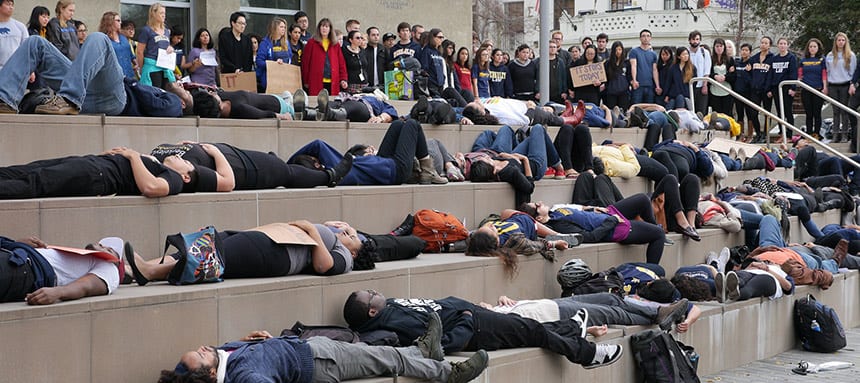
View full slideshow on Flickr.
By Andrew Cohen
More than 200 people attended a “die-in” Wednesday at Berkeley Law to protest police shootings and the recent grand jury decisions not to indict the white police officers who killed unarmed African Americans Michael Brown and Eric Garner.
The silent protest lasted 15½ minutes—11 for how many times Garner said “I can’t breathe” while being restrained by Staten Island police, and 4½ for the hours that Michael Brown’s body remained in the street after being shot at least six times by an officer in Ferguson, Missouri.
At the protest, 70 people of color lay down on the steps leading into the front of the law school while more than twice as many white students, faculty and staff stood holding hands in a large circle around them. Most wore Berkeley Law or UC Berkeley shirts and black pants, and many held sings reading “I Can’t Breathe” and “It Ends Now.”
The event was organized by the school’s Law Students of African Descent (LSAD). Salah Hawkins ’15, one of the group’s leaders, delivered powerful remarks before and after the die-in about “racialized police violence” and its far-reaching effects.
“This has happened in our country not just this year, but to our parents and grandparents and those before them,” he said. “It hits us hard because that could have been any of us. All the people you see laying down have experienced these same type of issues….For some people this may seem like it’s new and they may wonder why we’re so upset, why it’s hard for us to try to study during this time and to remain silent. But it’s not new, and we can’t just sit by anymore and allow them to keep treating us like we’re not human beings.”
Fellow LSAD member Trevor Burton ’15 said the decision to have only people of color lie down “was a strategic choice because white students are not affected directly by racialized police violence. This demonstration was about students of color being affected merely because they exist in different bodies, particularly black students who are the main recipients of the blows of state-sanctioned violence in terms of street police brutality.”
One of the white attendees, Heather St. Clair ’15, said she came because the gathering expressed her shared outrage that “our criminal justice system doesn’t recognize black people as having the same value as white people. To see these two unarmed men killed and the police officers not have to answer for it is deplorable. I came to law school because I care about social justice and equal treatment under the law. These decisions go against all of that.”
The Dean’s Office and Student Services unit hosted a three-hour discussion Tuesday about the grand jury rulings. Students and faculty members shared their views about the two cases, broader social justice issues, and what the school can do to address student questions about the legal outcomes. Berkeley Law is also coordinating a larger panel discussion in January that will dissect the legal issues related to Ferguson, Staten Island, and elsewhere.
On Wednesday, shortly before the protest, a statement signed by more than 80 faculty members expressed in part “despair and outrage about the killings of Michael Brown and Eric Garner… These cases again exposed the failure of the criminal justice system to value Black lives. The Brown and Garner cases have undermined our trust as legal scholars, advocates, and educators in the fundamental fairness of our legal system.”
Burton described the difficult “grand paradox” of trying to learn about the law largely in the absence of any real-world context.
“I’m studying something in the academic space that’s supposed to apply equally, but in my own life and in the lives of black people I know, by and large that’s not the case,” he said. “While I understand wading through facts is what we do as law students, when I describe being patted down when I was 16 because my headlight was out and another student says ‘Well, you don’t know what that officer was thinking,’ that’s hard to accept.”
For Hawkins, the grand jury decisions reveal a longstanding chasm between law’s purported intent and how it is often applied to African Americans.
“We have to fight for basic human rights, we have to fight for access to education, and we have to fight for the laws to be applied equally,” he said. “But the laws weren’t crafted to treat us equally.”